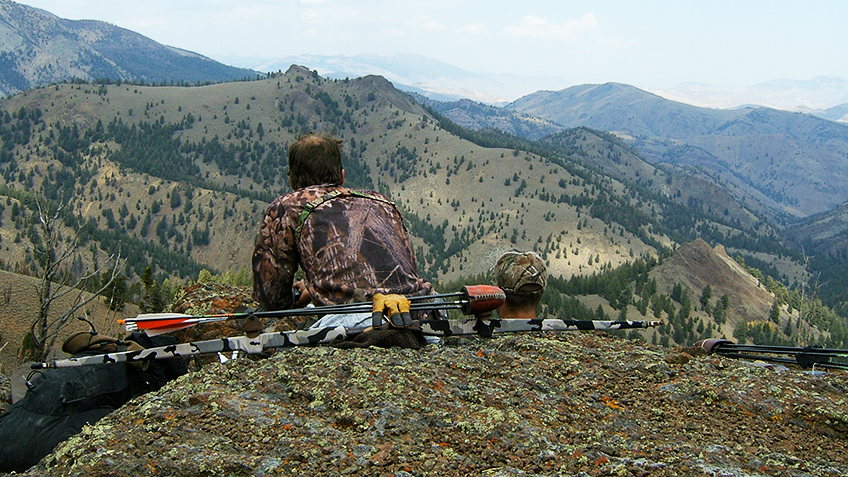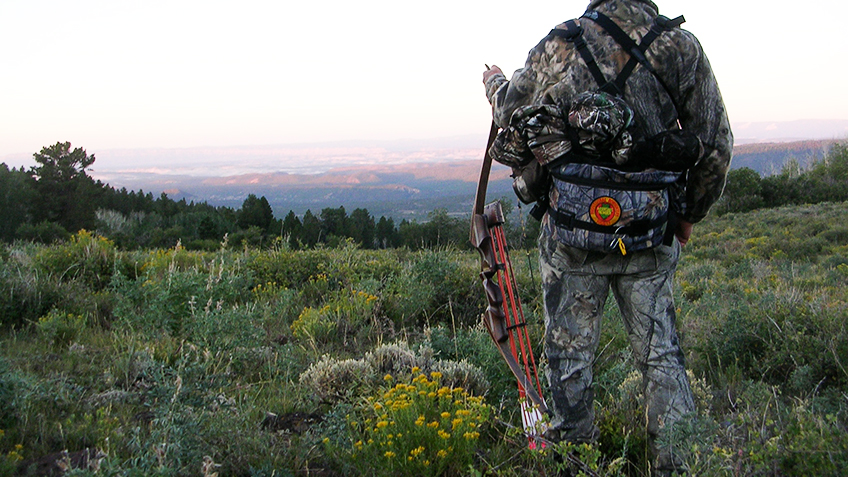
Four scant yards below me an honest-to-goodness Boone and Crockett mule deer browsed on bitterbrush. He was all of 32 inches wide outside, with rear forks big and deep enough to swallow a Navy destroyer. I’m still unsure how one gets that close to a buck that big without getting a shot opportunity, but I’m the guy who pulled it off. An hour later, though, the big buck’s buddy stopped by, offering me a 12-yard shot. After an easy blood-trailing job, my biggest-ever archery buck laid converted to meat by way of my longbow and feathered arrow.

Trailing Fred Bear
Bowhunting has a strong historic presence in North America’s hunting world; dominated now by sophisticated compound bows, laser rangefinders and mechanical broadheads. They are impressively lethal tools, capable of making accurate killing shots at ranges pushing 100 yards, in the right hands. But they can’t make a deer or elk any more dead—or any better tasting—than the equipment used by the pioneers of our bow hunting era; Fred Bear, Howard Hill and so on. Indeed, to my way of thinking, meat harvested by simple stick and string has just slightly better flavor than meat harvested with carbon and cable.

During my years as a western public-land guide and outfitter, I catered to traditional bow hunters. Many of them had hunted with a compound for years and craved the new challenge of going traditional. I was happy to oblige, for while I have killed deer and elk with compound bows, my heart has always belonged to the simplicity of traditional equipment. And, as I’ll detail later, within certain parameters, I consider traditional gear more capable than modern equipment.

Should You Switch to Traditional?
If you thirst for added challenge, long for simplicity and durability, and have a penchant for history-rich adventure, then yes, you should. Traditional archery gear has its advantages and disadvantages, but one thing is certain: It will make you become a better hunter and woodsman. Up for a challenge? Here’s how to get started.

Get the Gear
• Bow: I recommend starting with something inexpensive like a takedown Samick recurve, or a good used Bear recurve. You’ll want a bow that draws about 15 pounds less than your compound bow, because traditional bows don’t feature any let-off at full draw. After you’ve made the transition, developed some skill and are ready for a hunting bow, that’s the time to order a custom bow from Fox Archery or Stalker Stickbows. They build breathtakingly beautiful, high-performance bows to your specifications.

• Arrows: Get some feather-fletched Easton Axis carbon arrows. Yes, wood is more traditional and cooler, but it’s also more challenging to tune and less durable. Axis arrows are the toughest arrows I’ve used, and they’re relatively heavy. Where traditional arrows are concerned tough and heavy is good. You can transition to wood later, when you’re up for a bit of additional challenge.

• Glove or Tab: Your preference. I like a glove, but I know lots of great shooters who prefer tabs. A glove will protect your hand a bit better, and is—at least for me—slightly faster when loading an arrow and grasping the string. A tab will give you 2 to 3 more fps of arrow speed, and, some claim, a cleaner release. They also get lost easily. My advice is to try both and settle on whichever you like better.

• Quiver: I love the historic look and feel of a back quiver, but for bowhunting, I prefer a bow quiver. They hold your arrows secure and ready to hand, protect your broadheads, dampen string noise and vibration, and snake their way through brush far better than a back quiver ever could. Selway Archery makes my favorite bow quivers. You can get a quiver to fit any bow, and they’ll customize the rawhide hood with a laser-engraved image, logo, or whatever you want. Most importantly, they’re very high quality.

• Broadheads: Tighten your belt or snug up your suspenders; this one will be a real departure from your favorite compound equipment. Completely opposite your standard 80- to 100-grain modern mechanical heads, for traditional bowhunting, you want a heavy, fixed-blade, cut-on-contact broadhead that is re-sharpenable. Why? Well, that’s a subject of its own; essentially this type broadhead penetrates far better than its modern counterpart when shot from a traditional bow. My favorite broadhead? The 250-grain, 3-blade Woodsman available from 3Rivers Archery.
• Strings, Rests, Points and More: I prefer Flemish twist strings for their looks, durability and tune-ability. Make sure your arrow nocks clip onto the string, but just lightly. Tight nocks cause a lot of arrow flight problems. You can install a flipper-style rest above your bow’s shelf if you like, but personally I prefer to shoot directly off the shelf. It gets the arrow closer to my bow hand—a good thing for my style of shooting. I use contact cement to glue sealskin to the shelf and strike plate on my bow. Get an assortment of heavyweight field points for your arrows (available from 3riversarchery.com) ranging from 125 grains up to 300 grains. You’ll need them when you tune your arrows.

Adjust Your Shooting Style
In a world where you are used to dropping an arrow into your rest, snapping on a release, drawing the string through let-off, checking your level and settling a sight pin, and then squeezing off the shot, shooting a traditional bow is magically simple. You just knock an arrow, draw to solid anchor, and when the arrow looks right, you drop the string. It’s that simple.
In truth, though, it can be pretty hard to build great form and become consistently accurate. Here are a few do’s and don’ts that’ll help you along the way:
• DO: Tilt, or “cant” your bow. For a right-handed shooter, that means the bow will be in your left hand, and you’ll cant the bow toward the right. This’ll help the arrow stay on the shelf, and will get the upper limb a bit out of your sight window.
• DON’T: Try to shoot a traditional bow vertically. If you do, your arrow will tend to fall off the shelf, and arrow flight may not be as good.
• DO: Use just the ends of your fingers to draw the string. As you begin your draw, lay the string in the crease inside the last knuckles of your pointer, middle and ring fingers. Lock your pinky finger down to your palm with your thumb. At full draw, your pointer finger should fit against an upper tooth in the corner of your mouth, and the big knuckle at the base of your thumb should fit just behind the back of your jawbone.
• DON'T: Take a “deep hook” with your drawing fingers. If the string is too far up your fingers, you can’t release the string cleanly.
• DO: Use a full draw and a solid anchor. Find a tooth to anchor your pointer finger against, so your anchor point is the same every time. Once at full draw, make sure your arm forms a straight line from the arrow back through your drawing wrist and elbow.
• DON’T: Snap shoot. This is by far the most common affliction among traditional shooters, and involves releasing before you reach a firm anchor. That’s just like having the rear sight on your rifle loose and flopping around, and will NOT support good accuracy. You must reach a solid anchor, and release when you’re ready—not before.
• DO: Shoot only two arrows per round. That way, your focus will stay sharp and your hands steady. I shoot two arrows at an 8-inch circle from 5 yards, then 10 yards, then 15 yards. If I miss the circle, I re-shoot that distance until I get both arrows in, then I move forward. I continue until I reach 50 yards or so, or until I loose focus or get tired.
• DON’T: Shoot lots of arrows per round. Your muscles, tendons and sinews will fatigue, and so will your focus.
• DO: Make like a statue as you release. A clean release is the single most important element to accurate shooting. The only thing that should move is your string hand, which should pull rear-ward as it releases the string, ending relaxed just above the drawing shoulder.
• DON’T: Make like a fish as you release. Any flopping, jerking, lunging or convulsing will adversely effect your shot. Keep your bow arm, head and everything else steady through the shot.
• DO: Follow through. A steady follow though is second in importance behind good form and release. Keep your eye on the target and your bow hand up until the arrow strikes.
• DON’T: Drop your bow arm or raise your head at the shot to see where the arrow goes. It’ll throw your shot.
• DO: Use good arrows that are matched to your bow. Get the right spine arrows, and then tune them by adjusting arrow length, point weight, brace height and nocking point height until they fly straight as, well, an arrow. This is a subject all its own. Check out The Traditional Bowhunters Handbook by T.J. Conrads for good info about tuning.
• DON’T: Use a hodge-podge of arrows. Miss-matched arrows will fly differently, confusing your subconscious (which is your aiming mechanism), rendering you incapable of consistent, accurate shooting.

Traditional Advantage
Comparatively handicapped at long distance, traditional equipment possesses certain advantages in close-up hunting scenarios. The main three, in my opinion, are handling speed, light weight and durability.
• Handling Speed: One year, I’d been guiding for weeks and the season was almost spent. I had just a few days left to try and fill my own spike or cow elk tag. I took my compound hunting. Three cow elk trotted rapidly through a small opening 11 yards to my fore, and I was unable to get a shot off on any of them. Smirking to myself afterward, I knew I would have killed one of those cows had my longbow been in my hand instead of my compound. It’s simply much faster to chamber an arrow, draw and shoot than any compound will ever be. In my opinion, out to 20 or 25 yards, traditional gear is superior in 95 percent of elk hunting scenarios. The same goes for deer, though I’d reduce that “superior” distance to 12 to 15 yards. Beyond that, the advantage goes to the compound bow.

• Light Weight: Pretty self-explanatory; lightweight simply means that a traditional bow is far easier to carry up steep mountains, maneuver through thick brush or to carry on a challenging stalk than any compound bow can ever be.

• Problem-Free Durability: While guiding, I’ve seen compound bows blow up, rests fail, quivers fall off, sights become nocked off, knocking loops and points move, and more. Most of those problems are not even possible on traditional gear. Sure, you can cut your string with a careless broadhead or break your bow using it to lever a log out of the trail, but by and large, traditional bowhunting gear is pretty impervious. Toss it off a ledge, climb down after it, and it’ll still shoot where you’re looking. The only spare parts you’ll need to carry are a spare string (pre-tuned) and a spare glove or tab.

Conclusion
Pick up a longbow or recurve, select some arrows and tune up your shooting for the fall season. The first time you climb a mountain, zip an arrow through a deer or elk’s lungs, or pin a grouse for dinner, you’re going to smile. No need to thank me, I’m smiling too.



































